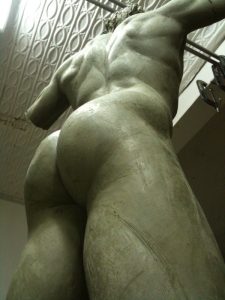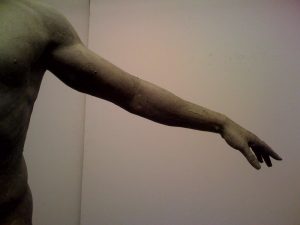The Art of Asking Questions
There’s a scene in the first HOME ALONE, a truly classic movie, where a child of about 5 years climbs into a van waiting to whisk a large family to the airport. The enterprising child besieges the driver with questions. He leans close into the driver and queries him relentlessly about all sorts of matters, a stunning barrage of interrogatory, verbal machine gun fire. The driver’s brain comes undone. He’s left rattled and nettled and hopelessly askew. It’s the first domino that falls in a trail of them, winding up with… a child left home alone to fend for himself during the holidays.
I think of this scene often (and isn’t that what makes a movie classic, the way particular scenes haunt you forever?). This scene comes to mind because I have a four-and-a-half-year old daughter who regularly enacts it. Daughter? Shall I call her the demon imp of questions, the patron saint of why, how, what, and how come?
As I write this, she sits next to me at the dining room table with a pad of paper. “What do we need from the store? Do we need sugar? How do I draw a ‘K’?” she asks. I surmise that she’s making a grocery list, something she’s watched me do a thousand times. “Can you show me how to draw a ‘K’?”
This is only the beginning. As long as she’s around me, and I don’t turn on the TV babysitter, she’s going to come up with questions. “Then what do we need, mama, after milk?”
“Eggs,” I tell her.
“How do you spell that? Do you like my ‘E’? Does ‘G’ have a kickstand like this? Do we need balloons? How do you spell ‘balloons’?”
It’s partly about observing and making sense of the world. The other day she launched herself like a missile into the bathtub and splashed around happily for a few minutes, making an aquarium of our bathroom. Then she turned serious. “Why does the water get higher when I get in? Why can’t I hear my hands when they clap underwater?”
So my hapless husband and I wracked our brains to explain the volumetrics of water to her.
Sometimes it’s about avoiding an unpleasant activity, like bedtime or picking up her crayons. Nothing will elicit a stream of questions like closing the cover of the last bedtime book. “How come the bear in that story has brown fur? Do all bears have brown fur? What about polar bears? Can you really fly all the way to the moon? How far away is the moon? Is the moon next door to the sun?” How long can she prolong the delicious moments of cuddling and conversation, before we flip off the light and close the door to her room?
And, naturally, the questions are about drawing my attention, or her father’s, or that of one of her three big sisters. This little sprite likes to engage with people. She enjoys the limelight. If she can draw us in with a question–she’s got us. She figured that out a long time ago. Not that it’s entirely self-serving. She can maximize the utility of what she’s doing, and suck in our attention while also… making sense of the world.
Most of the time I enjoy my little one’s questions. Sometimes they fry the gray matter rattling around in my cranium, sure. I get tired, I get exasperated, hey, I’m not the Buddha, and I don’t want to put together an explanation of why the sky is blue while I’m trying to make a dinner salad and, simultaneously, explain to my 14-year-old middle daughter why she can’t attend a football party where there will be 18-year-old men.
But often, in response to these questions, I experience the same piquant thrill that I do when I’m traveling. That is, I’m jolted out of my habitual way of seeing the world, and I look with new eyes, and fresh wonder, at the world around me. Isn’t the blue sky a kind of miracle, anyway?
My sweetie doesn’t do what adults sometimes do: disguise judgments as questions. This is the crucial difference, this matter of innocence. Her questions are really questions, not statements, even if they have an ulterior motive of getting me to pay attention to her or of getting her out of eating broccoli. She wants to know, and to understand. So her questions arise out of the innate art of our human core, the art of genuine curiosity.




 We (parents) want them (kids who know everything about instant messaging and the latest celebrity rehab, but who run screaming from museums and art books) to grow up knowing about more than Wii and the Xbox. We aspire for them to become literate, cultured people who can say something meaningful about Michelangelo’s Pieta and Degas’ dancers.
We (parents) want them (kids who know everything about instant messaging and the latest celebrity rehab, but who run screaming from museums and art books) to grow up knowing about more than Wii and the Xbox. We aspire for them to become literate, cultured people who can say something meaningful about Michelangelo’s Pieta and Degas’ dancers.


